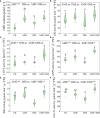The coexistence of arbuscular mycorrhizal fungi and dark septate endophytes synergistically enhanced the cadmium tolerance of maize
- PMID: 38855464
- PMCID: PMC11157013
- DOI: 10.3389/fpls.2024.1349202
The coexistence of arbuscular mycorrhizal fungi and dark septate endophytes synergistically enhanced the cadmium tolerance of maize
Abstract
Introduction: Arbuscular mycorrhizal fungi (AMF) and dark septate endophytic fungi (DSEs) generally coexist in the roots of plants. However, our understanding of the effects of their coexistence on plant growth and stress resistance is limited.
Methods: In the present study, the effects of single and dual inoculation of AMF and DSE on the growth, photosynthetic physiology, glutathione (GSH) metabolism, endogenous hormones, and cadmium (Cd) content of maize under 25 mg•kg-1 Cd stress were investigated.
Results: Compared with that after the non-inoculation treatment, AMF+DSE co-inoculation significantly increased the photosynthetic rate (Pn) of maize leaves; promoted root GSH metabolism; increased the root GSH concentration and activity of γ-glutamyl cysteine synthase (γ-GCS), ATP sulfatase (ATPS) and sulfite reductase (SIR) by 215%, 117%, 50%, and 36%, respectively; and increased the concentration of endogenous hormones in roots, with increases in zeatin (ZR), indole-3 acetic acid (IAA), and abscisic acid (ABA) by 81%, 209%, and 72%, respectively. AMF inoculation, DSE inoculation and AMF+DSE co-inoculation significantly increased maize biomass, and single inoculation with AMF or DSE increased the Cd concentration in roots by 104% or 120%, respectively. Moreover, significant or highly significant positive correlations were observed between the contents of ZR, IAA, and ABA and the activities of γ-GCS, ATPS, and SIR and the glutathione (GSH) content. There were significant or highly significant positive interactions between AMF and DSE on the Pn of leaves, root GSH metabolism, and endogenous hormone contents according to two-way analysis of variance. Therefore, the coexistence of AMF and DSE synergistically enhanced the Cd tolerance of maize.
Keywords: cadmium stress; endogenous hormone; endophytic fungi; glutathione metabolism; synergistic effect.
Copyright © 2024 Wang, Wang, Liang, Zhang, Li, Yang and Zhan.
Conflict of interest statement
The authors declare that the research was conducted in the absence of any commercial or financial relationships that could be construed as a potential conflict of interest.
Figures





Similar articles
-
Co-Inoculation with Arbuscular Mycorrhizal Fungi and Dark Septate Endophytes under Drought Stress: Synergistic or Competitive Effects on Maize Growth, Photosynthesis, Root Hydraulic Properties and Aquaporins?Plants (Basel). 2023 Jul 9;12(14):2596. doi: 10.3390/plants12142596. Plants (Basel). 2023. PMID: 37514211 Free PMC article.
-
Combined inoculation with dark septate endophytes and arbuscular mycorrhizal fungi: synergistic or competitive growth effects on maize?BMC Plant Biol. 2021 Oct 29;21(1):498. doi: 10.1186/s12870-021-03267-0. BMC Plant Biol. 2021. PMID: 34715790 Free PMC article.
-
Dark Septate Endophytes Improve the Growth and the Tolerance of Medicago sativa and Ammopiptanthus mongolicus Under Cadmium Stress.Front Microbiol. 2020 Jan 28;10:3061. doi: 10.3389/fmicb.2019.03061. eCollection 2019. Front Microbiol. 2020. PMID: 32047481 Free PMC article.
-
Co-inoculation of Lolium perenne with Funneliformis mosseae and the dark septate endophyte Cadophora sp. in a trace element-polluted soil.Mycorrhiza. 2018 Apr;28(3):301-314. doi: 10.1007/s00572-018-0826-z. Epub 2018 Mar 3. Mycorrhiza. 2018. PMID: 29502186
-
The role of arbuscular mycorrhizal fungi in the alleviation of cadmium stress in cereals: A multilevel meta-analysis.Sci Total Environ. 2023 Dec 1;902:166091. doi: 10.1016/j.scitotenv.2023.166091. Epub 2023 Aug 6. Sci Total Environ. 2023. PMID: 37553055 Review.
Cited by
-
Rice endophytic fungal community and its potential role on rice grains Cd accumulation.World J Microbiol Biotechnol. 2025 Jun 14;41(6):201. doi: 10.1007/s11274-025-04449-w. World J Microbiol Biotechnol. 2025. PMID: 40515945
-
The Three-Dimensional Structure of the Genome of the Dark Septate Endophyte Exophiala tremulae and Its Symbiosis Effect on Alpine Meadow Plant Growth.J Fungi (Basel). 2025 Mar 24;11(4):246. doi: 10.3390/jof11040246. J Fungi (Basel). 2025. PMID: 40278067 Free PMC article.
References
-
- AbdaAllah E. F., Hashem A., Alqarawi A. A., Bahkali A. H., Alwhibi M. S. (2015). Enhancing growth performance and systemic acquired resistance of medicinal plant Sesbania sesban (L.) Merr using arbuscular mycorrhizal fungi under salt stress. Saudi J. Biol. Sci. 22, 274–283. doi: 10.1016/j.sjbs.2015.03.004 - DOI - PMC - PubMed
-
- Anjum N. A., Ahmad I., Mohmood I., Pacheco M., Duarte A. C., Pereira E., et al. . (2012). Modulation of glutathione and its related enzymes in plants’ responses to toxic metals and metalloids-a review. Environ. Exp. Bot. 75, 307–324. doi: 10.1016/j.envexpbot.2011.07.002 - DOI
LinkOut - more resources
Full Text Sources

